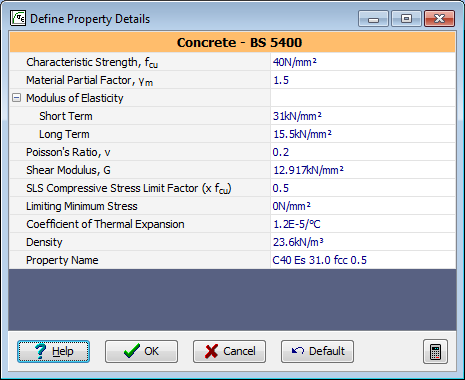Concrete Properties
Description
Definition of the material properties for a section or beam is a three step process:
- Add the material type (concrete / reinforcing steel / etc.)
- Define a set of properties for that material type (characteristic strength etc.)
- Allocate the material properties defined in 1 & 2 to the relevant parts of the section or beam section component.
This form performs the second of these 3 stages for concrete. As data is entered the program checks that values are within the expected range for concrete. This check will highlight any values in error by a factor of 10 or more. The displays for ULS and SLS are to the same scale, and are updated as the values in the fields are changed.
Form Graphic

Field Help
Characteristic strength fcu
Enter the characteristic strength of the concrete.
Material partial factor γm
Enter the partial safety factor for strength. Values not between 1 and 2 will be rejected. BS 5400 Part 4 specifies 1.50 in clause 4.3.3.3. BS 8110 Part 1 specifies 1.50 in Table 2.2. CS 455 Table 2.13a specifies:
- 1.50 for use with the characteristic strength,
- 1.20 for use with the worst credible strength.
Modulus of Elasticity - short term
Enter the modulus of elasticity of the concrete under short term (instantaneous) loading.
For BS 5400 the default value is taken from table 3 of BS 5400 Part 4.
For BS 8110 the default value is taken from table 7.2 of BS 8110 Part 2.
For Hong Kong HD the default value is taken from table 21 of the Hong Kong Highways Department, Structures Design Manual for Highways and Railways, 1993.
For analysis to BS 8110 equation 17 of part 2 is suggested:
E = 20 + 0.2 x fcu kN/mm2 (fcu in N/mm2)
Refer to section 7.2 of BS 8110 Part 2.
As elastic modulus, shear modulus and the Poisson's ratio are related, a change of this value will affect one of the three elasticity parameters, in this case the shear modulus.
Modulus of Elasticity - long term
Enter the modulus of elasticity of the concrete under long term loading. The default value is half the short term elastic modulus value, in accordance with clause 4.3.2.1 of BS 5400 Part 4.
Compressive stress limit factor
Enter the stress limitation factor for concrete in compression.
For BS 5400 refer to BS 5400 Part 4 clause 4.1.1.3 and Table 2 for suitable values. The following gives an aide memoir:
| reinforced | prestressed | |
|---|---|---|
| bending | 0.50 | 0.40 |
| axial | 0.38 | 0.30 |
For BS 8110 no value is suggested for reinforced concrete, but for prestressed concrete the values are given in clause 4.3.4.2.
Limiting minimum stress
A small tensile stress may be appropriate for Serviceability Limit State analysis. Any value entered here will not affect the Ultimate Limit State analysis.
For prestressed beam analysis, the value entered here will not be used. In this case the tensile stress is obtained from the concrete 'Class' classification as described in clause 6.3.2.4. of BS 5400 Part 4.
Coefficient of thermal expansion
Enter the coefficient of thermal expansion for use in differential temperature calculations.
The default value is 0.000012 /°C as suggested for normal weight concrete in clause 4.3.2.1 of BS 5400 Part 4.
For lightweight concrete and limestone aggregate concrete different values should be used. For analysis to BS 8110 refer to section 7.5 of Part 2.
Density
Enter the density of the concrete. This is used in the calculation of self-weight moments, and in the calculation of mass when beams are incorporated into a dynamic analysis.
The default value is 23.6 kN/m3 which is the widely accepted typical value for reinforced concrete.
Where the actual density is greater than this the tension stresses for pre-tensioned beams at transfer may be unduly conservative.
The value may depend upon the type of aggregate, the amount of reinforcement, and the degree of compaction.
Property name
The program will supply a reference name which provides an identifier to the material property set which is usually unique. This value may be edited to give a more readily recognisable name if required.
